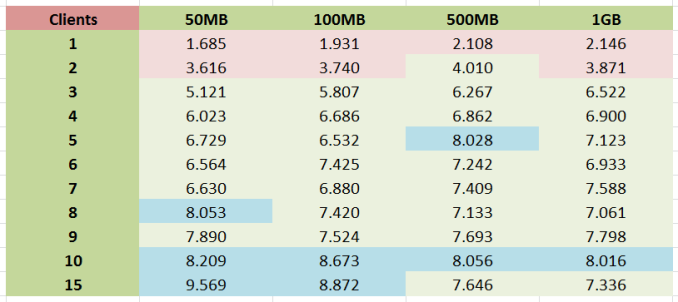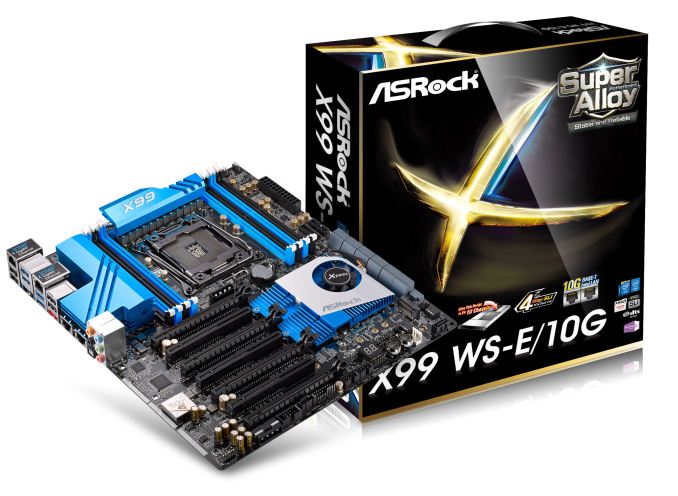ASRock X99 WS-E/10G Motherboard Review: Dual 10GBase-T for Prosumers
by Ian Cutress on December 15, 2014 10:00 AM EST- Posted in
- Motherboards
- IT Computing
- Intel
- ASRock
- Enterprise
- X99
- 10GBase-T
ASRock X99 WS-E/10G Conclusion
One could invite a saying 'the mind wants what the body can't have'. For a number of months and launches, I have wondered why there was a lack of 10GBase-T on consumer motherboards. The simple answer is that the X540 chips, or the Broadcom variants, are not only expensive but also power hungry enough require their own cooling but also require PCIe 2.0 x8 as a recommended minimum. It still baffles me why, despite these issues, it took so long to get on a product.
Our testing however shows the reality of the situation. In a single user point to point transfer, we yielded just over 2.0 Gbps, only 20% of the supposed rating. This was with a 1 GB transfer, with higher sizes increasing the speed up to a point. In order to get more than 2.0 Gbps, we needed to instigate multiple access streams to simulate more than one transfer request. The results pushed us into the 6-8 Gbps range from 4-10 streams and above 8 Gbps for 10+.
This puts a limit on the usefulness for a single individual. It means that the 10GBase-T network interface benefits from individuals that can emulate multiple access streams through software development (bulk information transfer such as MPI or rendering data) or in an SOHO/SMB environment where many users might want to be situated on VMs located on the machine. The motherboard is aimed at the workstation market with support for Xeons and RDIMMs, as well as 1U height clearance for servers too. I can imagine a server or workstation environment using this with several PCIe co-processors attached, each one assigned to a VM and being connected to via the 10G ports.
Due to the price of the controller, ASRock put the 10GBase-T on their highest end motherboard model under the premise that only extreme users will need it. As a result the board is equipped with two PLX8747 chips to allow for x16/x16/x16/x16 operation in a four-way GPU arrangement or x8/x8/x8/x8/x8/x8/x16 when single slot cards are in play. This opens up the market to PCIe coprocessors, RAID card arrangements and FPGA implementation workstations aplenty. Elsewhere on the board are twelve total SATA ports, eight USB 3.0 ports, two Intel I210 GBit ports alongside the two Intel X540-BT2 10Gbit ports, TPM, SATA DOM, M.2 x4 and an enhanced Realtek ALC1150 audio codec solution.
Benchmark results were pretty much ballpark for X99 at stock levels, with multicore turbo putting the CPU results up nearer the top. One disappointing note was the DPC Latency which was reasonable only when the X540 10GBit ports were disabled, suggesting that the combination of 10G drivers and BIOS are not yet optimized for this sort of scenario. However on the plus side POST times were not affected by the X540 controller.
In the end, despite not yet knowing the price of the ASRock X99 WS-E/10G, we can say that it will be expensive. This means possibly in the $700-900 range, due to all the higher end connectivity in play. For that reason alone, the only way this board will be sold is to those that need 10G but also multi-GPU bandwidth. With all that said, I'm still glad ASRock has shown that 10G is possible in the consumer space.












45 Comments
View All Comments
koekkoe - Wednesday, December 17, 2014 - link
One usage scenario: iSCSI storage, (especially when used also for booting) greatly benefits from 10G, because on 1G you're limited to 125MB/s, and big 16/24 disc arrays like EqualLogic can easily saturate also 10G bandwidth.petar_b - Thursday, December 18, 2014 - link
Xtreme11 used LSI SAS controller, it was awesome feature, I would happily pay for decent controller instead of slow SATA marvel ports - each time we add one more sata disk, overall disk transfer speed significantly drops. Thanks to LSI we can have 8 SSD SATA on SAS and they all perform 400MB/s even if used simultaneously. Marvel was dropping as low as 50MB/s with 8 SSD simultaneously used. What a lame.akula2 - Thursday, December 18, 2014 - link
I didn't prefer that board either -- not everything should be integrated from hardware scalability and fallback point of views. I'd prefer to build from a board such as Asus X99-E WS without filling up completely, and eventually choke it up!atomt - Saturday, December 20, 2014 - link
"It doesn't increase your internet performance"I beg to differ. 10Gbps internet is available for residential connections in my area. :-D
AngelosC - Wednesday, January 7, 2015 - link
Several things bother me with this review:1) Did I miss it or is there really no mention on how the VMs were accessing the X540? Was it running SR-IOV? Or VMXNET3? What network drivers were loaded in the VMs?
2) 10GE being the major selling point of the mobo but it was only tested using "LAN Speed Test" with results summarized into a simple chart? I suggest you could have also tested using netperf or iperf, showing results also from other OSes like CentOS? Performance difference between UDP and TCP/IP streams? If you just create packets and send, then receive packets and discard (as in the case of iperf3), you probably wouldn't have run into problem of having to place a file on a RAM disk and some other issues. And then if you ran iperf on Linux, you could have ran on bare metal, taking the VMS overhead out of the equation.
3) For sake of correctness, would you please clarify whether it was a X540-AT2 or X540-BT2?
To be frank, this review is below the standard I'd expect from AnandTech.